
Is the majestic and secular Turkey ready for its horde of tourists?
Amidst the magnificence great empires left behind, millions visit Istanbul to enjoy the city’s display of...
Nearly 42 million tourists flocked to Turkey last year, generating over $36 billion in revenue for its tourism industry and this year, Turkey is expecting more tourists than ever before.
Amidst more than a million other tourists, I too was one of them and visited Istanbul last week. The massive influx of people was evident from an aerial view of the airport, even before we touched down at the airport. Planes landed in quick succession, at intervals of barely a couple of minutes, and the immigration desk lines for foreign passport holders far exceeded those reserved for the locals.
The fruit of Turkey’s past efforts in aggressively promoting its many historical, cultural and natural wonders was evident. People from all parts of the world were queuing up to spend their savings, and a devalued Lira afforded access to Turkey’s many splendours.
All in all, this was good news for Turkey and tourists alike but there was a nagging question that surfaced and re-surfaced throughout my trip – can the Turks deal with the influx of an extraordinarily diverse and growing milieu of people at its centre?
I did my research and the numbers I found say it all. A quarter of the tourists who visit Turkey this year are also expected to visit Istanbul. According to an estimate by CNN, Istanbul will receive 12 million tourists in 2015 alone. The rest of the tourists will find beach resorts across Turkey’s Mediterranean and Aegean coast, or natural wonders across the mainland like Cappadocia, where life is more tranquil and more ‘Turkish’ compared to cosmopolitan Istanbul. And thus, the first ‘casualty’ of the influx is that Istanbul, a metropolis of 14.6 million people itself, might not be the best representative of Turkish culture when 12 million others mix to create a constantly changing blend, especially during the summers when tourism is at its peak.
 A view from the air. The lunar landscape of Cappadocia is just one of the settings for Inntravel's walks around Turkey. Photo: Reuters
A view from the air. The lunar landscape of Cappadocia is just one of the settings for Inntravel's walks around Turkey. Photo: Reuters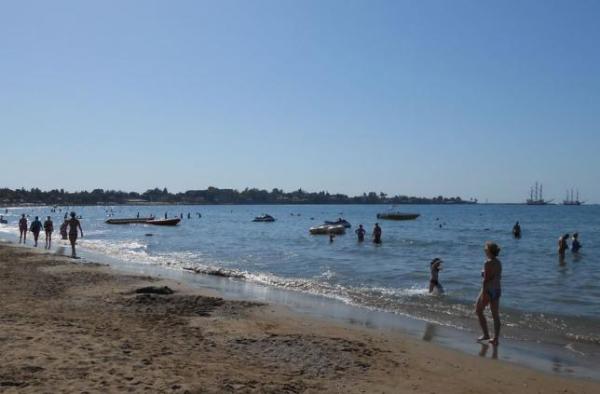 People are seen on the east beach in Side at Turkey’s Mediterranean. Photo: Reuters
People are seen on the east beach in Side at Turkey’s Mediterranean. Photo: ReutersA Lebanese friend I made described peak season Istanbul best as we walked behind our tour guide in Istanbul’s historically rich district, Sultanahmet. She said,
“It’s like getting tossed into a gigantic melting pot of cultures, where multiculturalism can sometimes overshadow a quintessential Turkish culture.”
I couldn’t agree more.
 Local and foreign visitors, with the Byzantine-era monument of Hagia Sophia in the background, stroll at Sultanahmet square in Istanbul. Photo: Reuters
Local and foreign visitors, with the Byzantine-era monument of Hagia Sophia in the background, stroll at Sultanahmet square in Istanbul. Photo: ReutersIn tour groups, that are prevalent, one encounters experiences that are not only specific to Turkey alone. Conversely, the diversity can also lead to a shared expression that transcends cultural boundaries and touches something deeper, something human. It all depends on how openly you wish to communicate with others around you.
For most tourists though, the language barrier may not allow a meaningful exchange with native Istanbullus, who are mostly preoccupied with inquisitive tourists. But the barrier will not rob tourists off the ‘Turkish’ experience either. A combination of various shows, eateries and tours, designed particularly for tourists, will showcase the Turkish way of life to a tourist for a certain fee. The guides are punctual, informative and commissioned after a four-year undergraduate course in tourism. Tour agencies are regulated and approved by the government and the cuisine supplementing these activities are always strictly Turkish.
 Turkish girls in traditional costumes. Photo: Pinterest
Turkish girls in traditional costumes. Photo: PinterestRegardless of how exceptionally well-organised the Turkish tourism industry is, the summer can dampen one’s spirits, simply because of all the heat, humidity and queues it brings along. I could have avoided this along with the temporary inflation in prices by planning a trip before June or after August, but then again, we don’t always have the luxury of taking breaks when we want them.
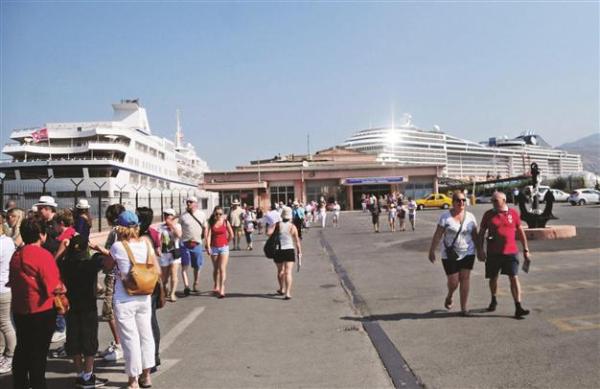 Rush of cruise ships to Aegean Town. Photo: DHA Photo
Rush of cruise ships to Aegean Town. Photo: DHA PhotoIn case you experience a similar misfortune, and if you must travel in the summer and happen to be staying in downtown Istanbul, know that genuine hospitality resides in the less exclusive, less crowded parts of town. The further you are from the centre of the city, the warmer the smiles. Hospitality may not be at the top of your agenda as you plan your vacation. After hours of flying boxed up in a plane, however, I can tell you one thing – a warm smile will go a long way in ironing out your spine.
The stress Istanbul feels under the weight of 12 million tourists is most palpable on the streets that are often clogged – again, a problem one can only avoid by not planning a trip around peak seasons. Tourists can also help themselves by simplifying communication. For instance, at eateries, after a couple of days, I was less miserable pointing at photographs of food than trying new pronunciations. In taxis, I started penning the exact address and phone number down on paper instead of flashing my phone at the driver who was often already divided between the traffic and another phone.
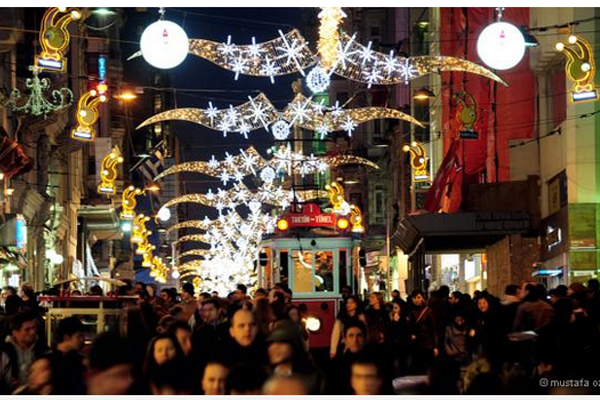 Holiday decorations light up the crowd in Istiklal street, a popular shopping route that runs from Taksim to Galata. Photo: AFP
Holiday decorations light up the crowd in Istiklal street, a popular shopping route that runs from Taksim to Galata. Photo: AFPFinally, when I reached my destination, almost all major historical and cultural sites offered audio guides. I could tune these to a language of my choice and give my deciphering muscles a break.
To sum it up, Istanbul has enough hotels, restaurants, bars, pubs, mosques, palaces, bazaars and boats to cater to a massive influx of vastly different tourists – rich and poor, ultra-conservative and ultra-liberal alike, but as millions pour in each year, the cultural exchange is more of a cultural showcase and the showcase is timed, limited and ticketed. Also, the setting is often more conducive to an exchange with other nationalities than the Turks themselves. For a relaxed yet Turkish immersive experience, I could have taken an outbound flight from Istanbul to any of the various destinations in the far corners of the country, all in less than two hours, but I didn’t have enough time for that.
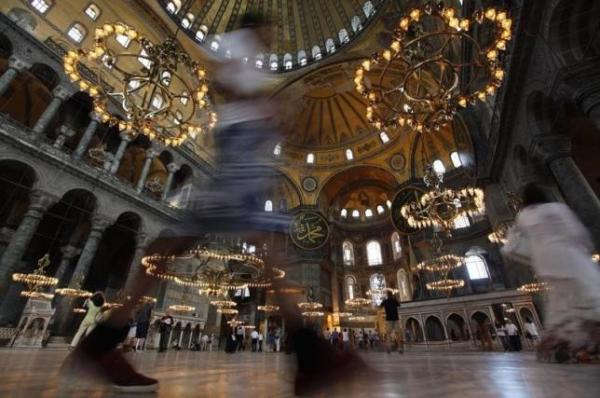 Local and foreign tourists visit the Byzantine monument of Hagia Sophia, or Ayasofya, which is now a museum in Istanbul. Photo: Reuters
Local and foreign tourists visit the Byzantine monument of Hagia Sophia, or Ayasofya, which is now a museum in Istanbul. Photo: ReutersChoose your district wisely
In Istanbul, the varying price of a half-litre water bottle is a good measure of the neighbourhood you are in and the prices you can expect in or around the vicinity. An easy to remember guide follows:
- Water under one Lira means you have somehow mixed with the Istanbullus and they will not fleece you – spend freely.
- Water at one Lira means the bare minimum tourist tax is on – bargain to no useful end.
- Water at two Liras means you’ve entered an upscale town – offer to pay half and be quick to jump shop.
- Water at three Liras and above means you are in swindle central and your pants can drop, anytime, without any warning – make good escape or find a part time job to clear accumulating dues.
Remember, the longer you stay in the three plus zone – which is primarily the Besiktas district in Istanbul – the sooner you will reach the end of your finite and dwindling budget.
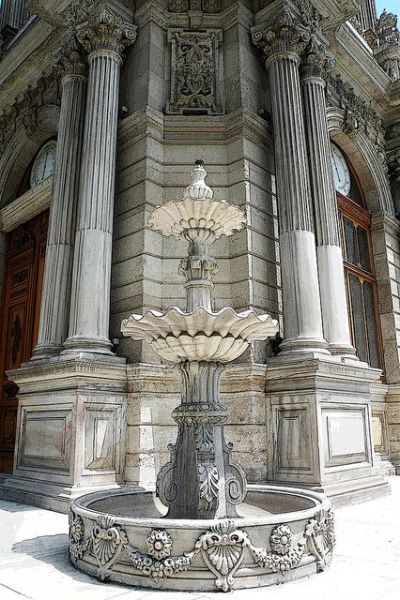 Dolmabahçe Palace Clock Tower, Istanbul, Turkey - located in the Beşiktaş district of Istanbul, Turkey, on the European coastline of the Bosphorus strait. Photo: Pinterest
Dolmabahçe Palace Clock Tower, Istanbul, Turkey - located in the Beşiktaş district of Istanbul, Turkey, on the European coastline of the Bosphorus strait. Photo: PinterestWord of caution: Besides outrageously expensive water, some of the high-end eateries and clubs in Besiktas can take hours to reach, especially on weekends. Every time I ventured from Beyoglu (where I was staying) to Besiktas (where many of the popular restaurants were) the roads were clogged and Turkish expletives punctuated the pleasure of the cool, night breeze.
 Beyoglu in the winters. Photo: Reuters
Beyoglu in the winters. Photo: ReutersThe locals looked annoyed, stiff, and reserved. I soon realised that enjoying a night in Besiktas without an ‘entertainment mobile’ to commute in, or without renting or owning a property on the exclusive Ciragan Caddesi or Muallim Naci Cadessi, was not a good idea. After a couple of lousy experiences, I neither had the financial health nor the mood to spend any more dollars. Consequently, I spent the rest of my evenings mixing, laughing and singing with the casual, infinitely warmer folks in the south of Besiktas and in the festive streets of Beyoglu where parties sprawled out of clubs, onto the streets where the festivity flowed deep into the night.
 A café on Muallim Naci Cadessi. Photo: Pinterest
A café on Muallim Naci Cadessi. Photo: PinterestRegardless of class, gender, nationality and sexual orientation, people flock to Istanbul and find districts to suit their needs best. Similarly, to make the most of my trip, my favourite district was Beyoglu, since it was central to everything and offered a vibrant nightlife. In any case, a brief overview of the most popular districts should be enough to help you decide where you want to stay.
 Nevizade Street. Istanbul, Turkey. Photo: Pinterest
Nevizade Street. Istanbul, Turkey. Photo: PinterestSultanahmet, Beyoglu and Besiktas are the areas most frequented by tourists. In terms of distance, these districts are not far from each other. In terms of traffic, however, commute times can range between 20 minutes and a couple of hours. So here’s another brief, easy to remember guide to the districts. The highest concentration of the most significant historical sites is in Sultanahmet.
By evening time, Beyoglu is arguably the most happening district in Istanbul – it is littered with enough restaurants, pubs, theatres, live music bars, clubs, museums, cultural centres and antique shops to keep you busy.
Besiktas is where the ultra-rich eat and dine and party and where glamorous cars and celebrities outnumber pedestrians. Also, in terms of relative proximity, imagine a diagonal line, dropping down from right to left; Besiktas is on the top right, Beyoglu next and Sultanahmet is in the bottom left.
 A view of the stadium at Besiktas. Photo: Pinterest
A view of the stadium at Besiktas. Photo: PinterestEssentially, Istanbul closes its doors to no one, and is always willing to accommodate the influx of en masse tourists. The Turkish government is even building the world’s largest airport, which is expected to become operational in 2017. This development will lead to a widening of the tourist floodgates. Whether or not this also leads to other equally necessary infrastructural growth to absorb heightened tourist traffic is yet to be seen.
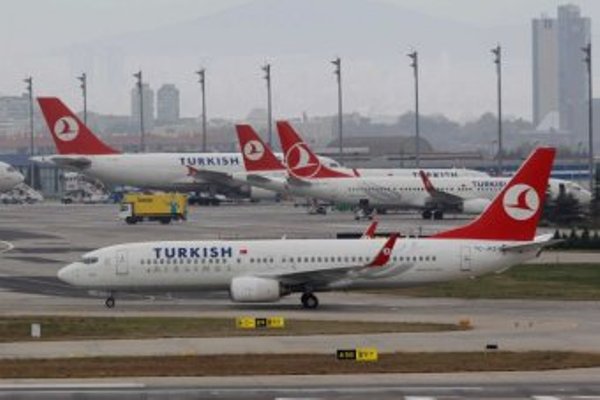 A Turkish Airlines plane prepares to take off from Ataturk International, which is currently the country’s largest airport. Photo: Reuters
A Turkish Airlines plane prepares to take off from Ataturk International, which is currently the country’s largest airport. Photo: ReutersFor starters, road congestion is a serious issue in Istanbul. To put things into perspective, 19 kilometres from my hotel to the airport, on a major three-lane highway, stole three hours of my time, and a six kilometres drive from Beyoglu to Besiktas for dinner took over an hour and so on.
 Bosphorus suspension bridge in Istanbul. Photo: Reuters
Bosphorus suspension bridge in Istanbul. Photo: ReutersVisa congestion
Besides traffic congestion in Istanbul, there is another kind of congestion the Turkish establishment needs to address immediately – the visa application process for Pakistani tourists.
The Turkish Embassy in Islamabad entertains 40 applications a day. For a population of 191.71 million people, a large proportion of which is now immersed in the alternative reality of Turkish soap operas, 40 applications a day are not nearly enough to meet the growing desire in Pakistan to visit Turkey. Forty applications a day means a maximum of 14,600 visas in a year. For a country that hosts 36.84 million tourists, with Germans taking the lead, is 14,600 visas not a stingy number?Indeed, Pakistanis with UK, US and Schengen visas can get an online visa to Turkey with a click of a few buttons, but what about travellers looking specifically to travel to Turkey? Considering all the recent song and dance about Pak-Turk friendship, why are the Turks avoiding us like the plague?
Additional visa officers at the embassy could ease the stress at the gates of the Diplomatic Enclave where aspiring travellers queue up several hours before the embassy opens shop. At the gates of the Diplomatic Enclave, an immense, body-hugging human chain waits to interact with a visa officer, and seldom finds one. Why? Because the 40-person list is designed to favour the few who either have private access to the Diplomatic Enclave or a contact at the embassy. Hence, when the shuttle service to the Enclave begins to operate at 6am, the list has already extended over 40 people and no new applications are entertained for the day.
About a month ago, when I too queued up for the shuttle service at 5:30am, I met other travellers who shared their frustrations with me. Some of them had been trying to reach the first 40 list for weeks and even on days when they took the first shuttle to the embassy, they were unable to make it through the gates because the list was invariably long.
So here’s another handy tip to the Turkish visa process. If you know any VIP – minister or a Member of Provincial Assembly (MPA) or a Member National Assembly (MNA) – you can arrive at the consulate or the embassy and hope to get your visa within a few hours. If you know someone at the Ministry of Foreign Affairs (MoFA) who knows someone at the Turkish Embassy, you can connect with the visa officer at the end of the day (at 12:30pm) and return to the embassy or consulate for your visa after a week. If you know someone at the Diplomatic Enclave, you may enter the Enclave at 5am before the shuttle service rush, get your name down on the first 40 list, and then get a notification to collect your visa in two to three weeks. If you are unable to do any of the above, apply for either a US, UK or Schengen visa, and then acquire an e-visa for Turkey within minutes online. I believe the process at the consulate in Karachi is better managed compared to Islamabad, but I have no first-hand experience of it.
Why all the hassle is worth it
Because Istanbul is the land of incredible stories – some mythical, some real. Some hidden and some not so hidden. Stories that are grand. Stories that will enlighten and amaze you.
For instance, Istanbul is the only place in the world that claims to showcase the staff Moses used to split the sea in two or the cloak Prophet Muhammad (PBUH) draped over his shoulders, and these are only two sacred relics among a series of others. Istanbul is also the only city in the world divided by a strait, spreading over two continents.
 Inside view of the Hagia Sophia dome in Istanbul - the fourth largest dome in the world today.The dome is no longer a perfect circle due to multiple restorative projects. Photo: Khizr Imran
Inside view of the Hagia Sophia dome in Istanbul - the fourth largest dome in the world today.The dome is no longer a perfect circle due to multiple restorative projects. Photo: Khizr ImranBeyond the richness of its architectural splendours from the Byzantine and Ottoman eras, and all the heritage it has managed to preserve, the undulating, multi-coloured landscape of Istanbul, dissected by the Bosphorus, adds a great deal of charm to the city – a charm most palpable at hill tops, Camlica Hill and Pierre Loti, and on the Bosphorus cruise.
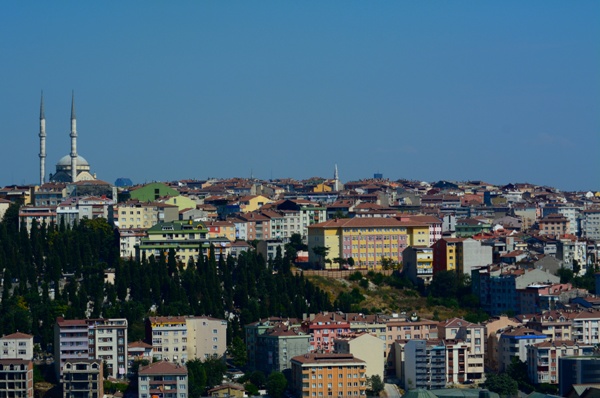 A view of the undulating city from a hill top restaurant, Pierre Loti Cafe, named after a French Naval Officer and Writer. A supporter of the Turkish War of Independence, and so a hilltop and a street in Istanbul was named after him. Photo: Khizr Imran
A view of the undulating city from a hill top restaurant, Pierre Loti Cafe, named after a French Naval Officer and Writer. A supporter of the Turkish War of Independence, and so a hilltop and a street in Istanbul was named after him. Photo: Khizr ImranEssentially, how Istanbul was built, destroyed and rebuilt over changing regimes and rulers, or how its culture evolved and endured countless challenges is a story best told in person, in the alleys, mosques, palaces and museums of the city, where locals embellish Istanbul’s story with the necessary detail.
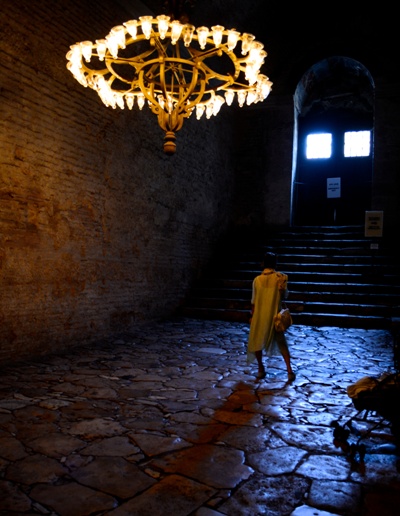 A passage inside Hagia Sophia. Floor dating back to 537. Chandelier dating back to 1847. Model in yellow dress dating back to August 12, 2015. Photo: Khizr Imran
A passage inside Hagia Sophia. Floor dating back to 537. Chandelier dating back to 1847. Model in yellow dress dating back to August 12, 2015. Photo: Khizr ImranI have returned to Lahore with many great stories but I can’t possibly recount all that fascinated me. So I will leave you with a myth and a reality that intrigued me the most.
The myth is about the mysterious Bosphorus that wasn’t a busy thoroughfare for European travellers until steamboats arrived in the 50s. Before that, the strait was known for entrapping and maybe even digesting many a ship, given its unpredictable undercurrents, taking direction from both the Sea of Marmara and the Black Sea. Much before the Bosphorus earned a reputation for troubling sailors, however, the Greeks named it Bous phorous, which meant ‘passage of the cow’.
On one of the tours I took, the tour guide elaborated. She said,
“According to Greek Mythology, Zeus one day seduced a priestess named Io. Zeus turned Io into a cow so that he could disguise her from his wife, Hera. But Hera was smarter than that. She understood everything, so she dispatched a swarm of flies to torment Io, the cow. To escape the wrath of the flies, Io swam across the strait separating Europe from Asia, and thus the strait came to be known as the Bosphorus.”
The other story is of Istanbul’s reality of mosques and dogs. In Pakistan, it’s strange enough to mention the two in the same sentence. In Istanbul, however, animals coexist with places of worship; it’s common to see cats and dogs straying around mosques. I was able to photograph one such dog. However, what absolutely amazed me is when I saw people praying in shorts and no one was pointing fingers at them, claiming who or what was ‘inappropriate’.
Animals in Istanbul are pets of the city administration and the locals. The animals are fed and loved and they know a freedom that goes beyond any freedom that could ever be known to man. It’s a beautiful sight to see carefree cats and dogs on the streets and religious sentiments that are more personal and private than punitive.
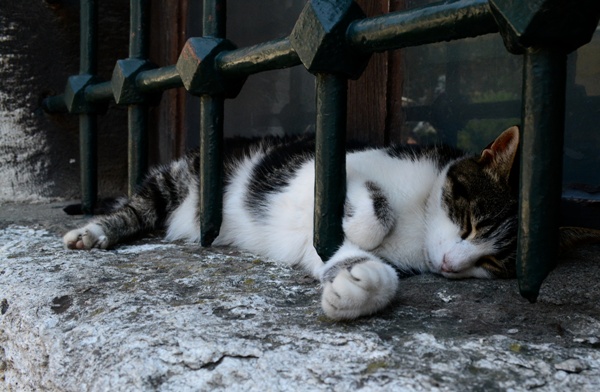 Perhaps the only place in the world where all animals are adored and looked after like royalty. Photo: Khizr Imran
Perhaps the only place in the world where all animals are adored and looked after like royalty. Photo: Khizr ImranAmidst the magnificence great empires left behind and the many other attractions, millions visit Istanbul to enjoy the city’s display of secularism that will please anyone who understands the pitfalls of uncompromising, fundamentalist Islamic thought.
Considering the handful Turkish visas Pakistanis scramble over each year, there is certainly not enough cultural exchange between the two countries to push Pakistan towards the secular ideal its founder envisioned at its birth. And until this exchange develops substantially, for Pakistanis secularism will have to be a tourist attraction, accessible by air, seven hours away.

COMMENTS (10)
Comments are moderated and generally will be posted if they are on-topic and not abusive.
For more information, please see our Comments FAQ